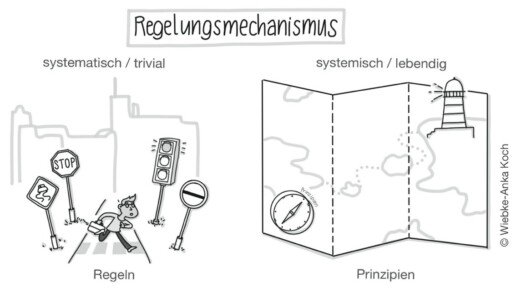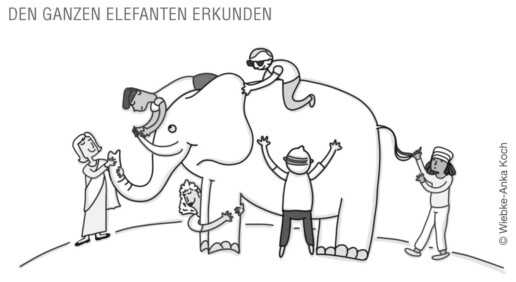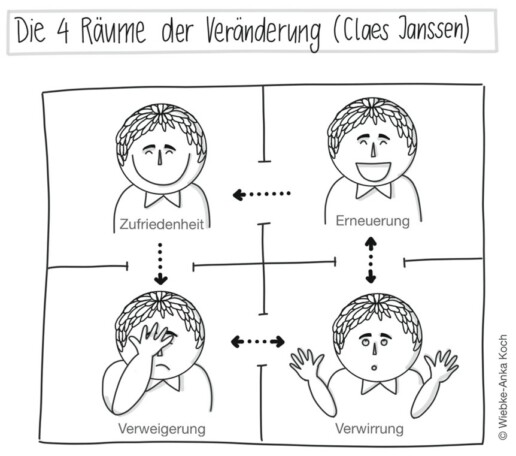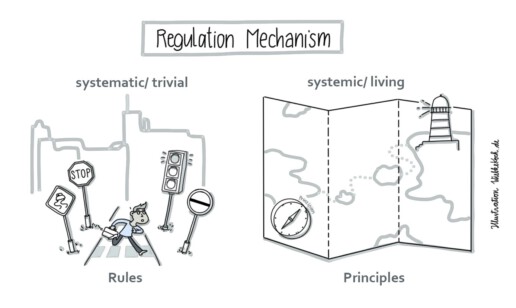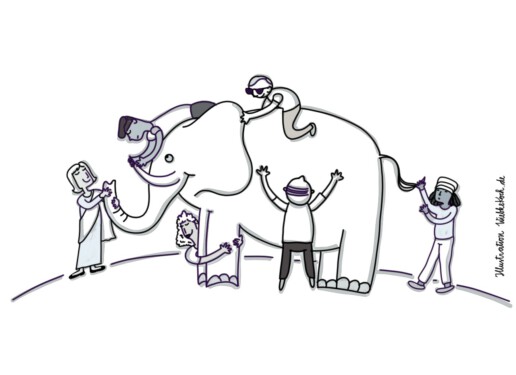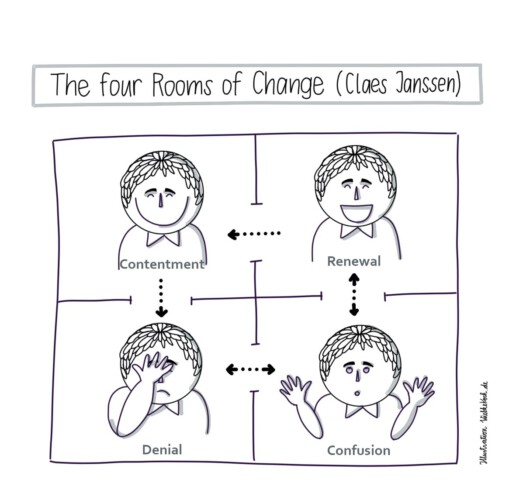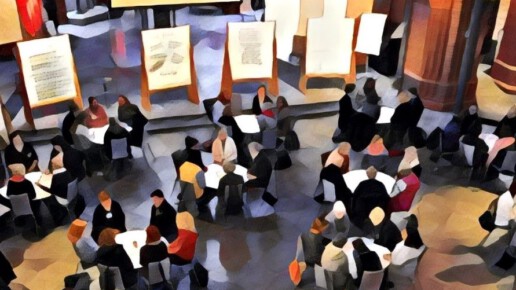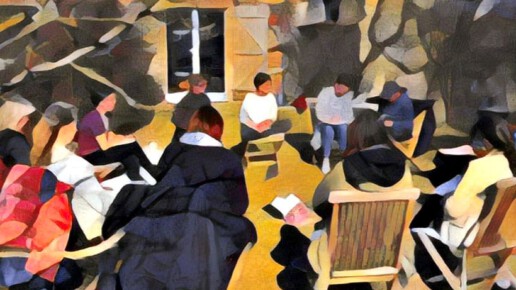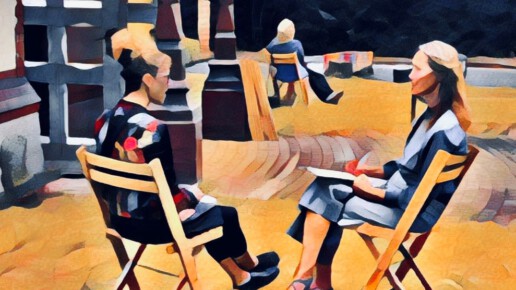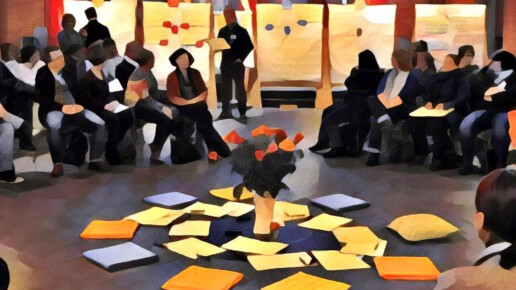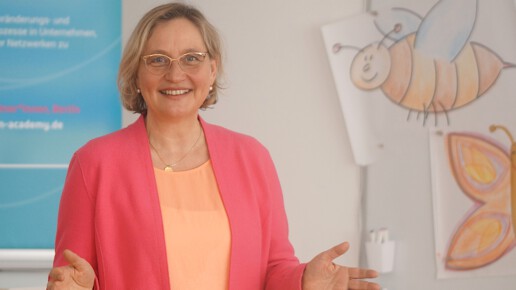*** English version see below ***
2 Regelungsmechanismus: Prinzipien und Metaphern statt Regeln Meine Grundsätze des #Facilitation, 2 von 8
Während für den Betrieb einer Maschine ein Regelwerk hilfreich sein mag, sind Prinzipien das Mittel der Wahl, um lebendige Systeme in ihrer Entwicklung zu unterstützen und Orientierung bei der Reise in bisher unbekannte Gewässer zu geben. Hier geht es um einen sehr wichtigen Punkt, der für uns einen großen Unterschied macht und an dem eine facilitative Haltung (oder das Fehlen derselben) deutlich wird. Immer wieder höre ich Kolleginnen und Kollegen von »Spielregeln« sprechen, wenn es darum geht, das Miteinander im Workshop zu gestalten.
Ich habe hier einen grundsätzlichen Einwand: Regeln machen zu, sie begrenzen das, was möglich ist. Vor allem, wenn sie von der Begleitung vorgegeben werden. Vorformulierte und gutgemeinte Regeln wie »in Ich-Botschaften sprechen«, »einander wertschätzend zuhören« oder »einander ausreden lassen« verändern nach meiner Erfahrung nicht das Kommunikationsklima eines Treffens – vor allem dann nicht, wenn es um Gefühle geht. Wenn es hoch hergeht, wenn die tiefer liegenden Themen nach oben kommen, wenn Differenzen sichtbar werden und die Gruppe sich in der »Knautschzone« des Prozesses (mehr dazu bei der Methode »Partizipationsdiamant«) befindet, dann sind solche Regeln meist unwirksam und im schlimmsten Fall kontraproduktiv.
Regeln sind wichtig im Straßenverkehr und im Sport. Wenn es aber um menschliche Prozesse geht, wenn wir einen belastbaren und gleichsam möglichst sicheren sozialen Raum benötigen, sind Prinzipien das Mittel der Wahl. Prinzipien öffnen und geben Orientierung, sie erteilen uns eine Lektion in Demut und laden zu einer zukunftsorientierten Erkundung ein.
So gelten die Prinzipien von Open Space für uns seit Beginn unserer Praxis als handlungsleitend und immer wieder neu auf tausendfache Weise – und das nicht nur im Workshop, sondern im ganzen Leben:
- Die da sind, sind genau die Richtigen.
- Was auch immer geschieht, ist das Einzige, was geschehen konnte.
- Es fängt an, wenn die Zeit reif ist.
- Vorbei ist vorbei – nicht vorbei ist nicht vorbei.
- Und: Augen auf – mit Überraschungen ist zu rechnen.
In der Praxis bedeutet das, dass wir ganzheitliche und partizipative Arbeitsweisen nutzen, zum Beispiel »Hoffnungen und Befürchtungen«. Hierbei trägt die Gruppe zu Beginn einer Veranstaltung selbst alles zusammen, was sich ereignen soll und was nicht. Gleichzeitig wird ein »Gruppenkontrakt« oder ein »Arbeitsbündnis« hergestellt und meine Rolle als Facilitatorin mit allen geklärt.
»Hoffnungen und Befürchtungen«
Diese Praxis geht zurück auf die Arbeit von Birgitt Williams (2014) und den »Genuine Contact«-Ansatz: ein holistischer Ansatz zur Organisationsentwicklung. Mehr dazu findest du unter http://genuinecontact.net.
Ich lasse dazu in kleinen Gruppen (vier bis sechs Personen) auf einem Flipchart Gedanken zur Frage sammeln: »Was sind meine/unsere Hoffnungen und Befürchtungen in Bezug auf diese Veranstaltung heute?« Dafür gebe ich 15 Minuten Zeit, anschließend präsentieren die Kleingruppen ihre Flipcharts. Nach der Präsentation frage ich »Was denkt ihr jetzt?« und warte ab, lasse ein paar Teilnehmende sprechen und frage dann nach: »Wer ist aus eurer Sicht dafür zuständig, dass eure Hoffnungen heute erfüllt werden und eure Befürchtungen nicht zu sehr zum Vorschein kommen?« Auch nach dieser Frage warte ich ab, was kommt. Meist wird dann gelacht und wir verständigen uns darauf, dass alle im Raum dafür zuständig sind, jede und jeder Einzelne in seiner/ihrer Rolle.
Wir hängen die Plakate später gut sichtbar im Raum auf. Sie dienen zur Erinnerung. Ich gehe nicht weiter auf die Inhalte der Plakate ein. Häufig tun dies jedoch die Teilnehmenden selbst, vor allem dann, wenn es schwierig wird. Wenn zum Beispiel jemand bei den Befürchtungen aufgeschrieben hat »Wir verzetteln uns« und es sich im Prozess für jemanden so anfühlt, dann sagt diese Person »Jetzt passiert genau das, was wir nicht wollten – wir verzetteln uns. Lasst uns …« Das ist Selbststeuerung und viel effektiver, als wenn ich mit einem mahnenden Finger an »Regeln« erinnere!
Die Arbeitsweise »Hoffnungen und Befürchtungen« bringt noch weitere Dinge nach vorn:
- Sie betont die Selbstverantwortung, dass alle für das Vorankommen an diesem Tag zuständig sind. Das ist das Gegenteil einer an mich gerichteten »Erwartungsabfrage«, bei der ich »liefern« muss, und macht noch einmal unsere Arbeitsteilung und die facilitative Haltung klar.
- Hoffnungen und Befürchtungen beziehen sich auf Gefühle, die Menschen mitbringen. Sie werden damit explizit eingeladen und »erlaubt«. Es entsteht eine entsprechende Gruppenkultur, die ermöglicht, die aufkommenden Gefühle auch zu äußern.
- Gleichzeitig entsteht ein gemeinsamer Bezugspunkt im Raum. Die Teilnehmenden setzen sich auch in Beziehung zu Impulsen, die andere hineingebracht haben.
Eine wichtige Metapher, die wir immer dann benutzen, wenn es darum geht, verschiedene Perspektiven im Raum wertzuschätzen, ist die Geschichte von den sechs blinden Männern und dem Elefanten. Sie kommt aus Südasien (dort ist sie so bekannt wie hierzulande »Hänsel und Gretel«) und geht vereinfacht folgendermaßen:
Den ganzen Elefanten erkunden
Sechs blinde Männer wollten wissen, was ein Elefant ist. Sie gingen in einen Tempel und wurden dort in einen Raum geführt, in dem ein sehr großer Elefant stand. Der erste berührte ein Bein und sagte: »Ah, ein Elefant ist ein Baum.« Der zweite erfühlte den massigen Körper und sagte »Nein, der Elefant ist eine Wand!« Ein weiterer stand am Schwanz und sagte: »Oh, ein Elefant ist wie ein Pinsel, etwas borstig, und er bewegt sich.« Einer der Blinden stand bei den Ohren und stellte fest: »Nein, ein Elefant ist wie ein großer Fächer, der sich hin und her bewegt.« Ein weiterer befühlte die Stoßzähne und berichtete: »Ein Elefant ist ein großer Speer.« Der sechste hielt den Rüssel in der Hand und widersprach den anderen: »Nein, meine lieben Freunde, der Elefant ist ein Schlauch und vorn etwas nass.« Die Männer fingen an zu streiten und der Tempelwächter kam und sagte: »Ihr habt alle recht und zusammen habt ihr unrecht – wenn ihr einander zuhören würdet, dann wüsstet ihr, was ein Elefant ist.«
Diese Geschichte erzählen wir in vielen Variationen (auch politisch korrekt mit Menschen in einer dunklen Höhle) zu Beginn eines Workshops und laden die Teilnehmenden ein, sich vielleicht daran zu erinnern, wenn sie in einer Situation das Gefühl bekommen, den anderen nicht zu verstehen und recht haben zu wollen. Wir hängen ein Plakat im Raum auf und lassen es die ganze Zeit dort hängen. Die Geschichte hat eine interessante indirekte Wirkung und trägt zu einem Klima des Zuhörens bei. Die Lacher beim Einführen der Geschichte verdeutlichen mir immer wieder, wie gut Menschen die geschilderte Situation kennen – zum Beispiel, weil verschiedene Abteilungen im Unternehmen oder Interessengruppen bezüglich einer Fragestellung die gleiche Sache sehr unterschiedlich bewerten können.
Wenn wir »den ganzen Elefanten« erkunden wollen, müssen wir die unterschiedlichen Perspektiven wahrnehmen, um zu den richtigen Schlussfolgerungen zu kommen und die Zukunft gemeinsam zu gestalten. In Workshops, bei denen das Thema »Veränderung« implizit oder explizit eine Rolle spielt (und das sind die meisten), nutzen wir außerdem das Modell der »Vier Räume der Veränderung« (Janssen 1996).
Vier Räume der Veränderung
Das Modell dieser vier Räume der Veränderung wurde vom schwedischen Psychologen Claes F. Janssen entwickelt. Es bezieht sich auf die Arbeit von Elisabeth Kübler-Ross, die über innere Prozesse bei unheilbar Kranken forschte und ihre Erkenntnisse anhand einer »Veränderungskurve« veröffentlichte. Diese Kurve umfasst folgende sieben Phasen:
- Schock
- Ablehnung
- rationale Einsicht
- emotionale Akzeptanz
- Ausprobieren
- Erkenntnis
- Übernahme
Daraus hat Claes F. Janssen die vier Räume der Veränderung entwickelt:
- Zufriedenheit
- Verweigerung
- Verwirrung
- Erneuerung
Dieses Modell besagt in Kürze, dass wir verschiedene Phasen und emotionale Zustände durchleben, um uns in einer neuen Situation zurechtzufinden und zu lernen.
Wir beginnen im Raum der Zufriedenheit. Das bedeutet nicht, dass wir mit allem zufrieden sind, sondern dass wir mit den Anforderungen unserer Umgebung in gewohnter Weise umgehen können, uns sozusagen in der »Komfort-Zone« befinden. Dann geschieht etwas (und das kann im Workshop die Auseinandersetzung mit einer anderen Meinung sein), und ich gehe in einen Raum der Verweigerung. Das ist völlig natürlich und dient unserem eigenen Schutz, indem ich mein »Ego bürste« und behaupte, recht zu haben, mich verweigere, aussteige und so weiter. Irgendwann sehe ich ein, dass ich mich verändern oder anpassen muss, und dann begebe ich mich automatisch in einen Raum der Verwirrung. Dieser Raum fühlt sich meist auch nicht gut an, denn dort spüre ich meine eigene Unfähigkeit, mit dieser komplexen Situation umzugehen. Ich stelle fest, dass ich lernen muss. Wenn ich dann genug gelernt und neue Kompetenzen erlangt habe, gelange ich in den Raum der Erneuerung, in dem ich mich wieder wohlfühle, und erneut im Raum der Zufriedenheit sein kann.
Wir erläutern das Modell ganz kurz anhand eines Plakats. Dann ermuntern wir die Teilnehmenden mit folgenden Worten: »Möglicherweise werdet Ihr Euch im Laufe unseres Workshops in dem einen oder anderen Raum wiederfinden, das ist völlig natürlich. Und egal, wo Ihr seid, es gehört dazu und ist in Ordnung. Wir laden Euch zusätzlich dazu ein, falls Ihr Euch irgendwann im Raum der Verwirrung aufhalten solltet, dort ein klein wenig länger zu bleiben, als Ihr es normalerweise tut. Denn im Raum der Verwirrung entsteht das Neue, hier wohnt die Kreativität, und die können wir hier gut gebrauchen. Natürlich nutze ich dieses Modell vor allem, um mich selbst zu reflektieren, und nicht, um Kolleginnen oder Kollegen zu belehren. Aber wenn jemand feststellt: ‚Ich bin wohl im Raum der Verweigerung!‘, dann gibt es meist ein Lachen im Raum – Humor hilft immer! «
__________
Mehr zu den Grundsätzen des Facilitation in meinem „Mini Handbuch Facilitation“, Beltz-Verlag 2021, oder in unseren Ausbildungsangeboten auf www.facilitation-academy.de
Wir möchten besonders auf unsere folgenden Ausbildungsangebote hinweisen:
1-jährige Ausbildung zum Facilitator
Seminar Interne Prozessbegleitung
Facilitation Basics Online
© Jutta Weimar – Dieser Text ist urheberrechtlich geschützt. Leicht veränderter Auszug aus dem Buch „Mini-Handbuch Facilitation“, erschienen 2021 beim Beltz Verlag. Alle Rechte vorbehalten. Mehr Informationen zu Facilitation unter: www.facilitation-academy.de
***English Version***
2 Regulation Mechanisms: principles and metaphors instead of rules.My principles of #facilitation 2 of 8
While a set of rules may be helpful for operating a machine, principles are the treatment of choice to support living systems in their development and to offer guidance when forwarding into unknown fields.
This is a very important point that makes a big difference for us, and where a facilitative attitude (or lack thereof) becomes clear. Again and again, I hear colleagues talk about „rules of the game“ when it comes to shaping togetherness in the workshop.
I have a fundamental objection here: rules constrict, they limit what is possible. Especially when they are imposed by the facilitator. In my experience, pre-formulated and well-intentioned rules such as „speak in I-messages,“ „listen to each other appreciatively,“ or „let each other finish what they have to say“ do not change the communication climate of a meeting – especially when emotions are involved. When things get heated, when the deeper issues come to the surface, when differences become visible and the group is in the „crumple zone“ of the process (more on this in the method „Participation Diamond“), then such rules are usually ineffective and in the worst case counterproductive.
Rules are important in road traffic and in sports. But when it comes to human processes, when we need a resilient and at the same time as safe as possible social space, principles are the means of choice. Principles open up and provide orientation, they teach us a lesson in humility and invite us to explore in a forward-looking way.
Thus, the following principles of Open Space have been guiding our actions since the beginning of our practice, and they are always new in a thousand ways – not only in the workshop, but in all of life:
– Those who are there are exactly the right ones.
– Whatever happens is the only thing that could happen.
– It starts when the time is right.
– Over is over – not over is not over.
– And: keep your eyes open – surprises are to be expected.
In practice, this means that we use holistic and participatory ways of working, for example „hopes and fears“. Here, at the beginning of an event, the group itself gathers everything that should and should not happen. At the same time, a „group contract“ or „working alliance“ is established and my role as facilitator is clarified with everyone.
„Hopes and Fears.“
This practice goes back to the work of Birgitt Williams (2014) and the „Genuine Contact“ approach: a holistic approach to organizational development. You can find out more at http://genuinecontact.net.
To do this, I have small groups (four to six people) gather thoughts on a flip chart around the question, „What are my/our hopes and fears about this event today?“ I give 15 minutes for this, then the small groups present their flipcharts. After the presentation, I ask, „What do you think now?“ and wait, let a few participants speak, and then ask, „From your perspective, who is responsible for making sure your hopes are met today and your fears don’t come out too much?“ Even after this question, I wait to see what comes. Usually there is then laughter, and we agree that everyone in the room is responsible for this, each and every one in his/her role.
We later hang the posters prominently in the room. They serve as a reminder. I do not go into further detail about the content of the posters. Often, however, the participants do this themselves, especially when things get difficult. For example, if someone wrote down „We’re getting bogged down“ in the fears, and it feels that way to someone in the process, then that person says „Now exactly what we didn’t want to happen is happening – we’re getting bogged down. Let’s …“ This is self-direction and much more effective than me reminding people of „rules“ with an admonishing finger!
The „hopes and fears“ way of working brings other things forward:
– It emphasizes self-responsibility, that everyone is responsible for moving forward that day. This is the opposite of „asking for expectations“ directed at me, where I have to „deliver,“ and once again makes clear our division of labor and facilitative attitude.
– Hopes and fears refer to feelings that people bring with them. They are thus explicitly invited and „allowed“. A corresponding group culture is created, which makes it possible to express the feelings that arise.
– At the same time, a common point of reference is created in the room. The participants also relate to impulses that others have brought in.
An important metaphor that we always use, when it comes to valuing different perspectives in space, is the story of the six blind men and the elephant. It comes from South Asia (where it is as well known as „Hansel and Gretel“ in this country) and, in simplified terms, goes like this:
Explore the whole elephant
Six blind men wanted to know what an elephant was. They went to a temple and were led into a room, where there was a very large elephant. The first touched a leg and said, „Ah, an elephant is a tree.“ The second sensed the massive body and said „No, the elephant is a wall!“ Another stood by the tail and said, „Oh, an elephant is like a brush, a little bristly, and it moves.“ One of the blind people stood by the ears and stated, „No, an elephant is like a big fan that moves back and forth.“ Another felt the tusks and reported, „An elephant is a big spear.“ The sixth held the trunk in his hand and contradicted the others, „No, my dear friends, the elephant is a tube and a little wet in the front.“ The men began to argue and the temple guard came and said, „You are all right and together you are wrong – if you would listen to each other, you would know what an elephant is.“
We tell this story in many variations (including the politically correct one with people in a dark cave) at the beginning of a workshop and invite participants to perhaps remember it, when they get the feeling in a situation that they don’t understand the other person and want to be right. We hang a poster in the room and leave it there the whole time. The story has an interesting indirect effect and contributes to a climate of listening. The laughs when the story is introduced, always make it clear to me how well people know the situation being described – for example, because different departments in the company or interest groups can have very different opinions about the same thing with regard to an issue.
If we want to explore „the whole elephant,“ we need to perceive the different perspectives in order to come to the right conclusions and shape the future together.
In workshops, where the topic of „change“ plays an implicit or explicit role (and most of them do), we also use the model of the „Four Spaces of Change“ (Janssen 1996).
Four spaces of change
The model of these four spaces of change was developed by Swedish psychologist Claes F. Janssen. It refers to the work of Elisabeth Kübler-Ross, who researched inner processes in terminally ill patients and published her findings using a „change curve.“ This curve includes the following seven phases:
– shock
– rejection
– rational insight
– emotional acceptance
– trial and error
– realization
– acceptance
From this, Claes F. Janssen has developed the four spaces of change:
– Contentment
– Denial
– Confusion
– Renewal
This model states in a nutshell that we go through different phases and emotional states in order to adjust and learn in a new situation.
We start in the space of contentment. This does not mean that we are satisfied with everything, but that we are able to deal with the demands of our environment in a familiar way, being in the „comfort zone“, so to speak. Then something happens (and in the workshop this can be the confrontation with a different opinion), and I go into a space of denial. This is perfectly natural and serves to protect ourselves by „brushing my ego“ and claiming to be right, refusing, opting out, and so on. At some point, I realize that I need to change or adapt, and then I automatically enter a space of confusion. This space usually doesn’t feel good either, because there I feel my own inability to deal with this complex situation. I realize that I need to learn. Then, when I have learned enough and gained new competencies, I get to the space of renewal, where I feel comfortable again, and can be in the space of contentment once more.
We explain the model very briefly using a poster. Then we encourage the participants with the following words: „You may find yourself in one room or another in the course of our workshop, that is completely natural. And no matter where you are, it’s part of it and it’s okay. We invite you additionally, if at any time you find yourself in the room of confusion, to stay there a little bit longer than you normally do. For it is in the space of confusion that the new arises, it is here that creativity resides, and we can make good use of it here. Of course, I use this model primarily to reflect on myself, and not to lecture colleagues. But when someone states, ‚I guess I’m in the space of denial!‘ there’s usually laughter in the room – humor always helps! “
_____________
More about the principles and practice of facilitation in my „Mini Handbuch Facilitation“, published 2021 by Beltz-Verlag, or in our training offers on www.facilitation-academy.de
Join us in our Facilitation Trainings (in German):
1 year Facilitation Training
Inhouse Facilitator
Facilitation Basics Online

